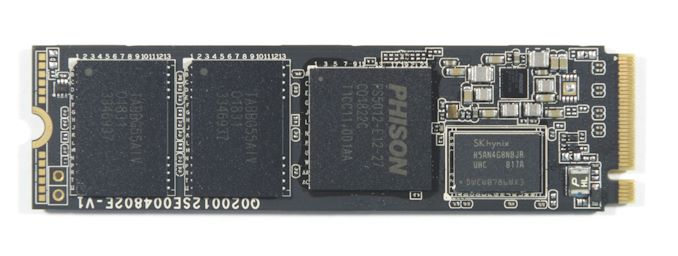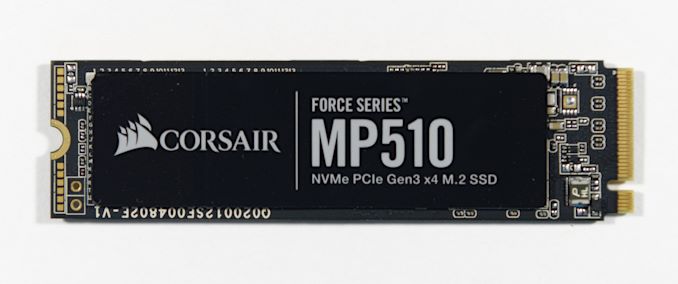
Original Link: https://www.anandtech.com/show/13438/the-corsair-force-mp510-ssd-review
The Corsair Force MP510 SSD (960GB) Review: A High-End Contender
by Billy Tallis on October 18, 2018 10:00 AM EST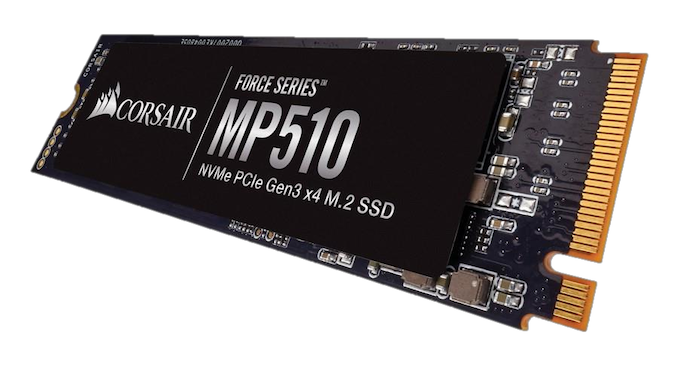
The Corsair Force Series MP510 may appear at first glance to be an incremental update to the earlier MP500, but under the sticker it's an entirely new and far better drive. The MP500 was Corsair's take on the Phison E7 first-generation NVMe SSD controller paired with planar MLC NAND. The MP510 adopts the new Phison E12 controller and Toshiba's 64-layer 3D TLC NAND. The result is a drive that aims for the high end and actually makes it this time.
Earlier this year, we previewed the Phison E12 controller and its M.2 SSD reference design. The Corsair Force MP510 is based on that same hardware platform and features the same firmware version number, so not much should have changed except for the application of a Corsair logo and price tag. The Phison E12 is the high-end controller from their second generation of NVMe controllers, with the E8 as the entry-level NVMe controller with fewer PCIe lanes and NAND channels. Phison has close ties to Toshiba, and most Phison drives use Toshiba's NAND flash. Toshiba's transition to 3D NAND was relatively late and that stuck many Phison SSD vendors with uncompetitive SSDs last year, including most drives with the E7 controller. Toshiba's 64-layer 3D TLC has reversed that situation and is giving Phison SSD vendors access to cutting-edge flash that is fast, cheap, and power efficient. Phison's E12 controller allows drives to make the most of that flash.
| Corsair Force Series MP510 Specifications | ||||||
| Capacity | 240 GB | 480 GB | 960 GB | 1920 GB | ||
| Form Factor | double-sided M.2 2280, PCIe 3 x4 | |||||
| Controller | Phison PS5012-E12 | |||||
| NAND Flash | Toshiba BiCS3 256Gb 64-layer 3D TLC | |||||
| Sequential Read | 3100 MB/s | 3480 MB/s | 3480 MB/s | 3480 MB/s | ||
| Sequential Write | 1050 MB/s | 2000 MB/s | 3000 MB/s | 2700 MB/s | ||
| Random Read | 180k IOPS | 360k IOPS | 610k IOPS | 485k IOPS | ||
| Random Write | 240k IOPS | 440k IOPS | 570k IOPS | 530k IOPS | ||
| Rated Power |
Read | 6.1 W | 6.7 W | 6.9 W | 7.1 W | |
| Write | 3.5 W | 4.8 W | 5.6 W | 6.2 W | ||
| Idle | 30 mW | |||||
| Warranty | 5 years | |||||
| Write Endurance | 400 TB 0.9 DWPD |
800 TB 0.9 DWPD |
1700 TB 1.0 DWPD |
3120 TB 0.9 DWPD |
||
| MSRP | $65.99 (27¢/GB) |
$124.99 (26¢/GB) |
$235.99 (25¢/GB) |
|||
The Corsair Force MP510 is available in capacities from 240GB to 960GB, with a 1920GB model on the way. That largest model has slightly reduced performance specifications from the 960GB that we have tested, and the smallest 240GB model has significantly constrained performance, with only the sequential read speeds still in high-end NVMe territory.
All capacities have a rated write endurance of around 0.9-1.0 drive writes per day and a five year warranty period, which are standard for high-end consumer SSDs. Maximum power draw ranges from 6.1-7.1W depending on capacity, so the drive will get warm but thermal throttling shouldn't be a problem outside of synthetic benchmarks.
The Corsair Force MP510 faces very direct competition from other Phison E12 SSDs such as the MyDigitalSSD BPX Pro, which the MP510 is surprisingly undercutting on price at the moment. Other competitors include:
- the Samsung 970 EVO and Western Digital WD Black, flagship TLC SSDs from major brands that are only a little bit more expensive than the MP510
- The HP EX920, ADATA SX8200 and other similar drives based on the Silicon Motion SM2262 controller, some of which are currently cheaper than the MP510
Also included in this review are several entry-level NVMe drives, our results from testing an engineering sample of the upcoming Silicon Motion SM2262EN controller, and the Toshiba XG6 OEM SSD that will hopefully get a retail version soon.
| AnandTech 2018 Consumer SSD Testbed | |
| CPU | Intel Xeon E3 1240 v5 |
| Motherboard | ASRock Fatal1ty E3V5 Performance Gaming/OC |
| Chipset | Intel C232 |
| Memory | 4x 8GB G.SKILL Ripjaws DDR4-2400 CL15 |
| Graphics | AMD Radeon HD 5450, 1920x1200@60Hz |
| Software | Windows 10 x64, version 1709 |
| Linux kernel version 4.14, fio version 3.6 | |
| Spectre/Meltdown microcode and OS patches current as of May 2018 | |
- Thanks to Intel for the Xeon E3 1240 v5 CPU
- Thanks to ASRock for the E3V5 Performance Gaming/OC
- Thanks to G.SKILL for the Ripjaws DDR4-2400 RAM
- Thanks to Corsair for the RM750 power supply, Carbide 200R case, and Hydro H60 CPU cooler
- Thanks to Quarch for the XLC Programmable Power Module and accessories
- Thanks to StarTech for providing a RK2236BKF 22U rack cabinet.
AnandTech Storage Bench - The Destroyer
The Destroyer is an extremely long test replicating the access patterns of very IO-intensive desktop usage. A detailed breakdown can be found in this article. Like real-world usage, the drives do get the occasional break that allows for some background garbage collection and flushing caches, but those idle times are limited to 25ms so that it doesn't take all week to run the test. These AnandTech Storage Bench (ATSB) tests do not involve running the actual applications that generated the workloads, so the scores are relatively insensitive to changes in CPU performance and RAM from our new testbed, but the jump to a newer version of Windows and the newer storage drivers can have an impact.
We quantify performance on this test by reporting the drive's average data throughput, the average latency of the I/O operations, and the total energy used by the drive over the course of the test.
The Patriot Hellfire, in blue, is highlighted as an example of a last-generation Phison E7 drive. Although we didn't test it at the time, the MP500 was based on the same controller and memory.
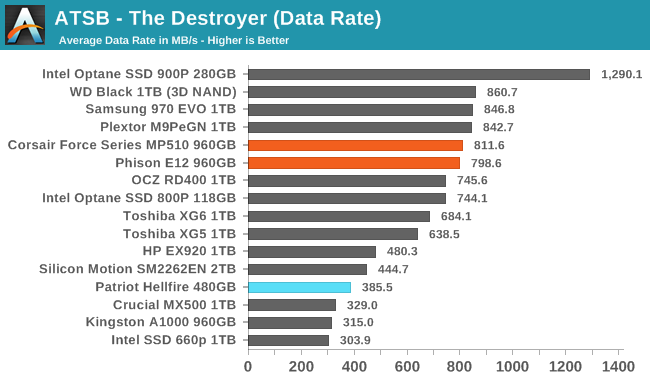
The Corsair Force MP510's average data rate on The Destroyer is only a few percent slower than the fastest TLC-based SSD we've tested, and is more than twice as fast as the previous generation Phison E7 drives.
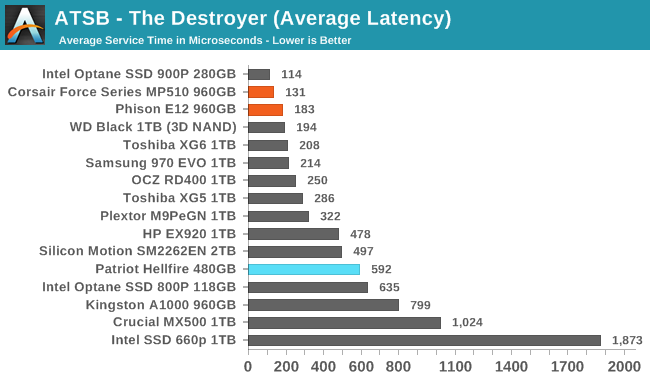
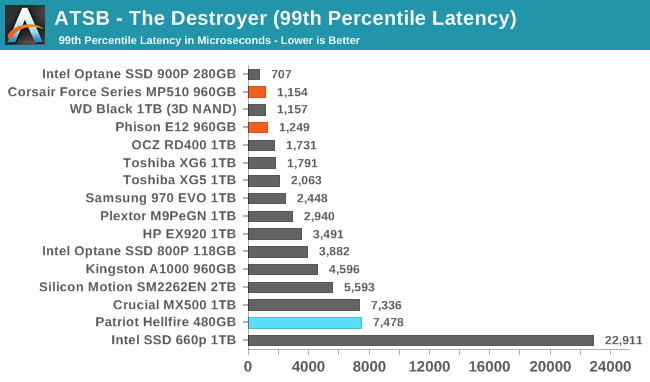
The average and 99th percentile latency scores from the MP510 are best in class, pulling slightly ahead of the other drives that use the same BiCS TLC NAND.
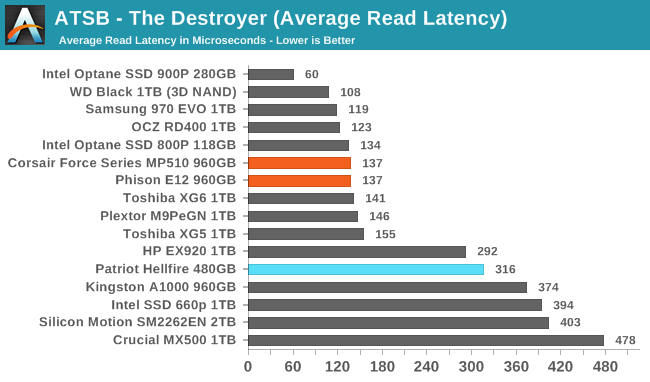
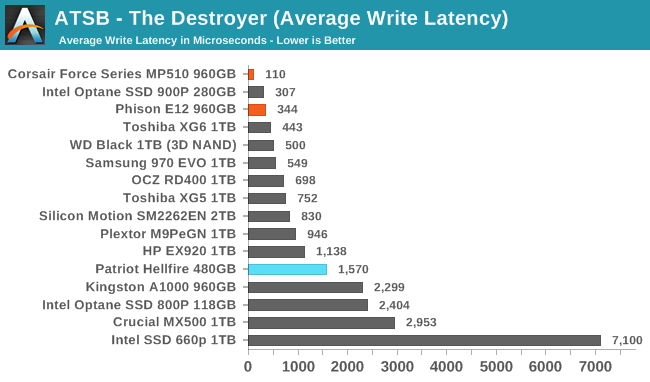
The average read latency of the MP510 is a bit slower than the fastest NAND-based SSDs but still clearly falls within the top tier of drives. The average write latency is impressively low, showing that the drive has very effective write caching.
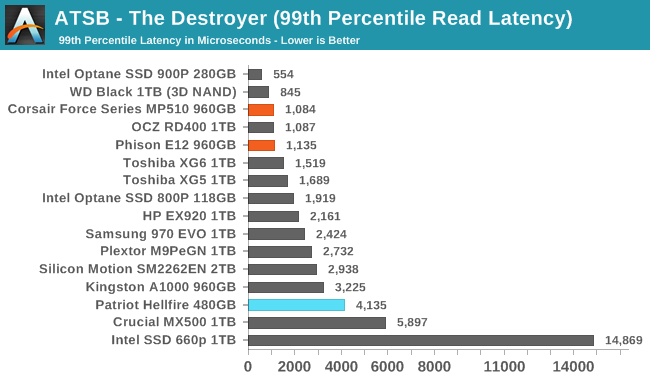
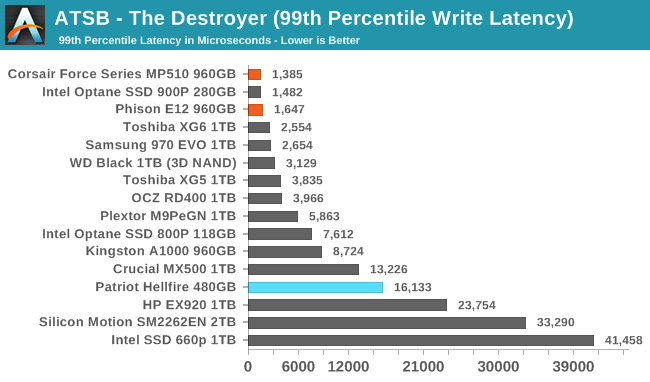
The 99th percentile write latency score for the Corsair MP510 is the best we've seen, and the 99th percentile read latency also excellent but doesn't quite set a new record.
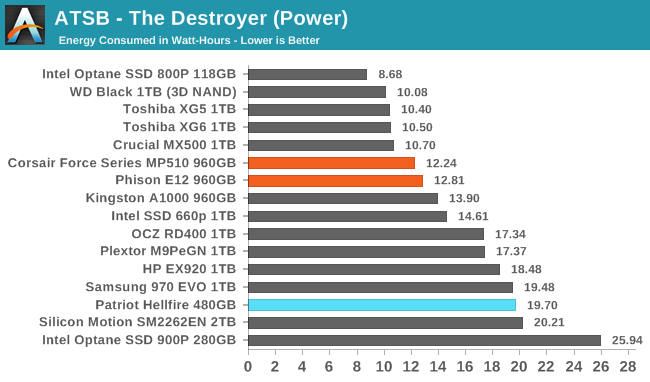
The Corsair Force MP510 uses a bit more energy over the course of The Destroyer than the most efficient flash-based SSDs (which use the same BiCS TLC NAND), but the MP510's efficiency is still significantly better than average for a high-end NVMe SSD.
AnandTech Storage Bench - Heavy
Our Heavy storage benchmark is proportionally more write-heavy than The Destroyer, but much shorter overall. The total writes in the Heavy test aren't enough to fill the drive, so performance never drops down to steady state. This test is far more representative of a power user's day to day usage, and is heavily influenced by the drive's peak performance. The Heavy workload test details can be found here. This test is run twice, once on a freshly erased drive and once after filling the drive with sequential writes.
The Patriot Hellfire, in blue, is highlighted as an example of a last-generation Phison E7 drive. Although we didn't test it at the time, the MP500 was based on the same controller and memory.
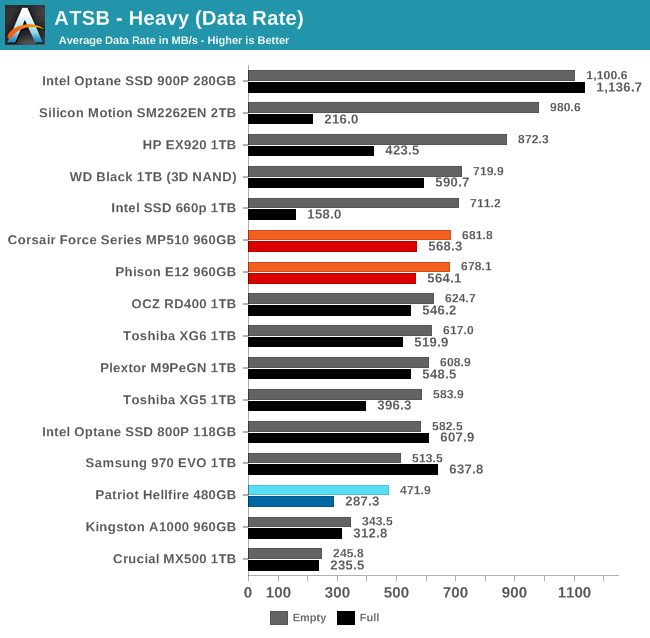
The Corsair Force MP510 cannot match the best-case data rates of the fastest drives using Silicon Motion controllers, but the MP510 does a much better job of maintaining performance even when the drive is full.
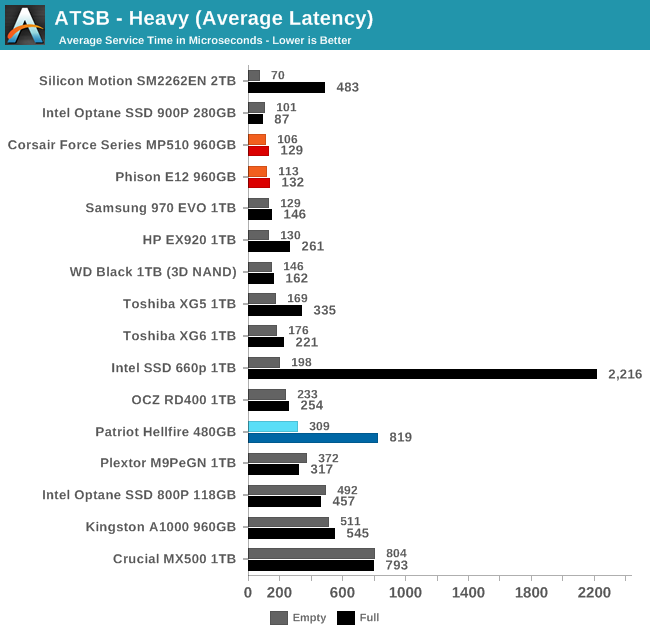
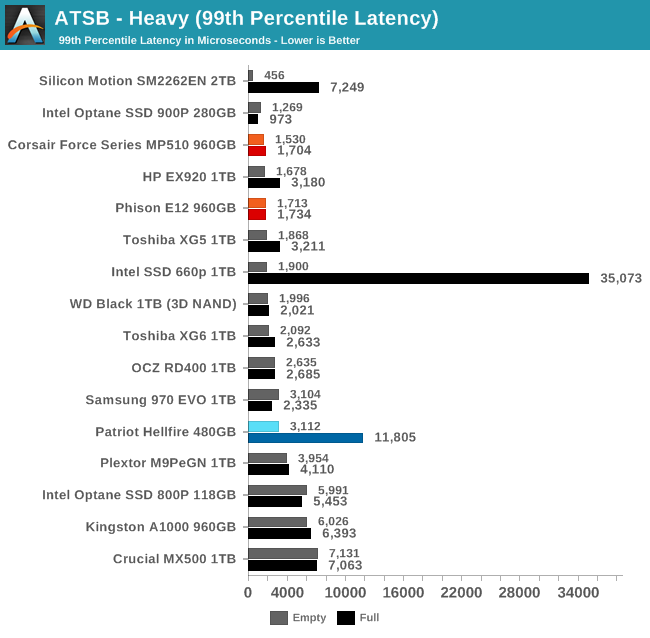
The average and 99th percentile latency scores for the Corair MP510 on the Heavy test are again some of the best we've seen, but the upcoming SM2262EN controller holds on to the top spot—when the test is run on an empty drive.
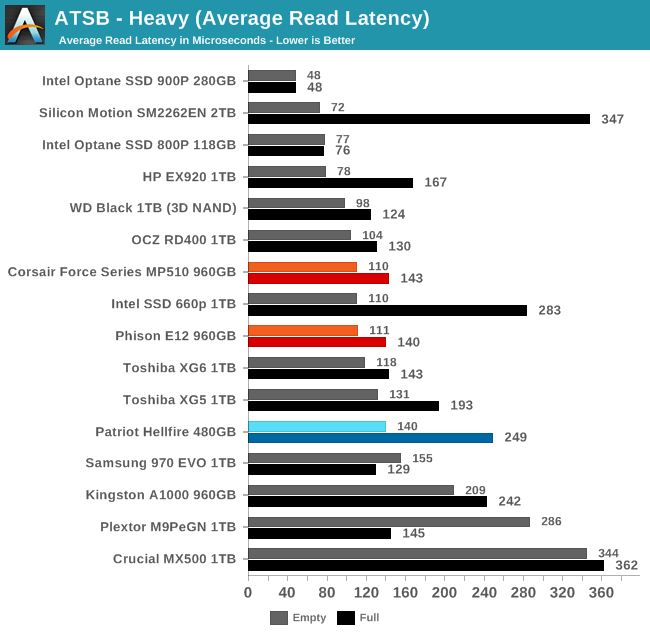
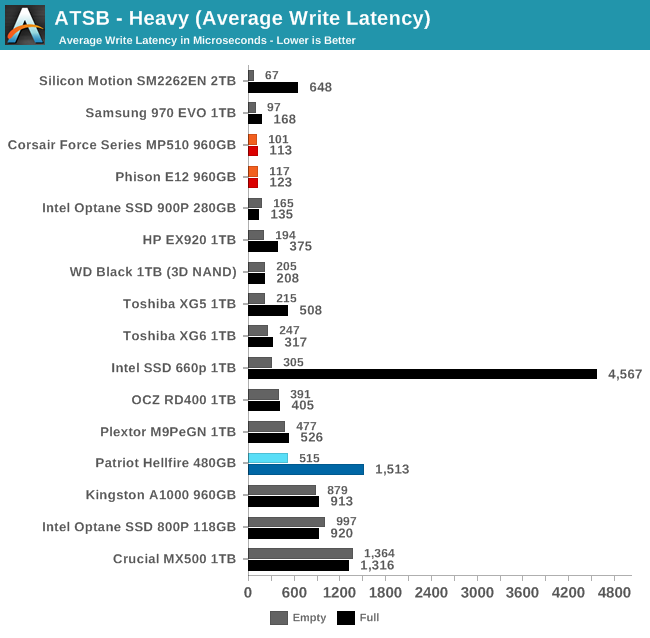
The average read latency scores from the MP510 are nothing special among recent high-end drives, but the average write latencies can only be matched by a few other drives.
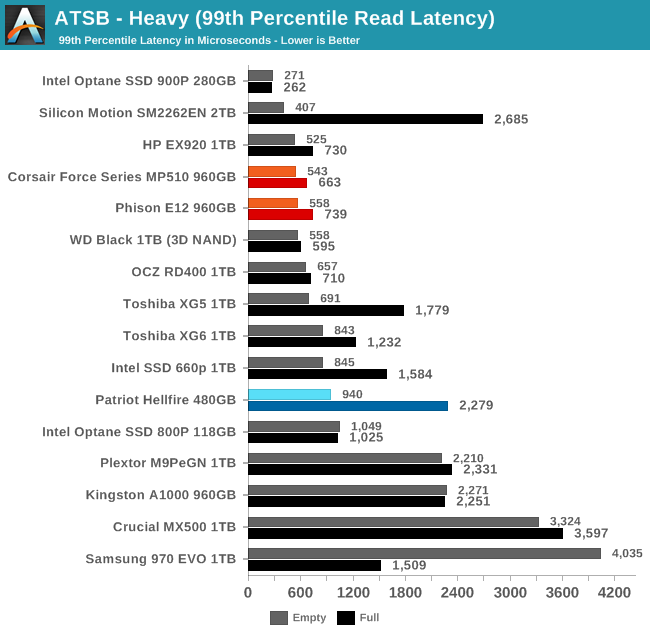
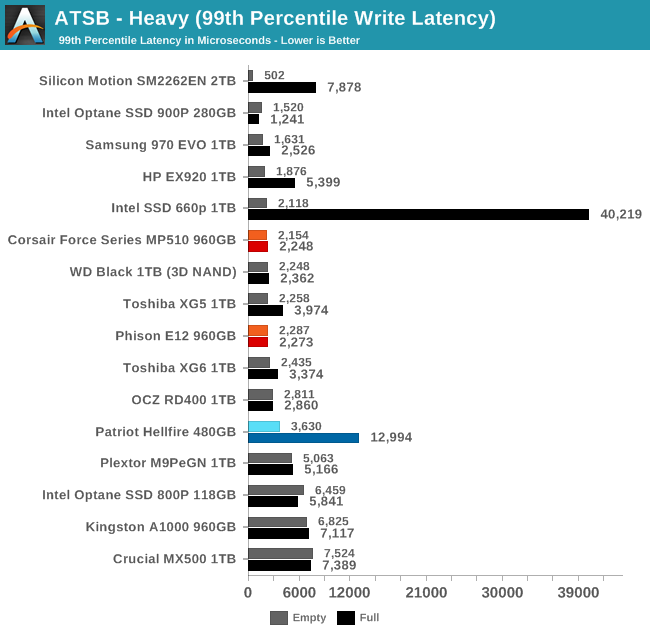
The 99th percentile read and write latency scores form the MP510 don't stand out much from other high-end drives, but the write scores in particular show very little performance penalty from running the Heavy test on a full drive.
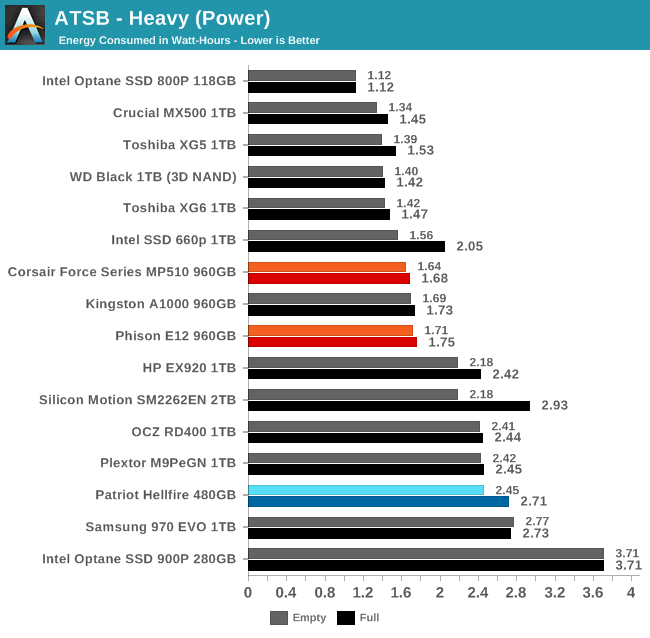
The Corsair MP510's total energy consumption during the Heavy test show it is not the most efficient NVMe SSD, but is one of few high-performance drives that approaches the efficiency typical of a good SATA drive.
AnandTech Storage Bench - Light
Our Light storage test has relatively more sequential accesses and lower queue depths than The Destroyer or the Heavy test, and it's by far the shortest test overall. It's based largely on applications that aren't highly dependent on storage performance, so this is a test more of application launch times and file load times. This test can be seen as the sum of all the little delays in daily usage, but with the idle times trimmed to 25ms it takes less than half an hour to run. Details of the Light test can be found here. As with the ATSB Heavy test, this test is run with the drive both freshly erased and empty, and after filling the drive with sequential writes.
The Patriot Hellfire, in blue, is highlighted as an example of a last-generation Phison E7 drive. Although we didn't test it at the time, the MP500 was based on the same controller and memory.
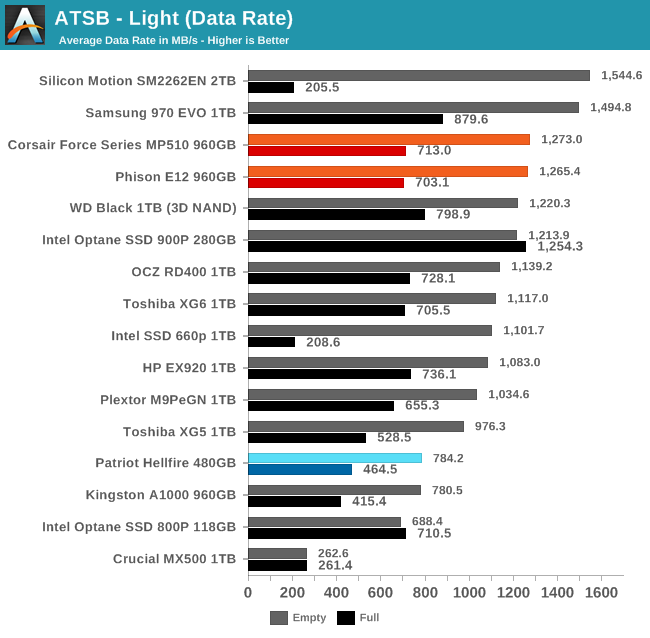
The average data rates from the Corsair Force MP510 show a much larger performance hit for running the Light test on a full drive than we saw with the Heavy test, but in either case the MP510 maintains competitive performance.
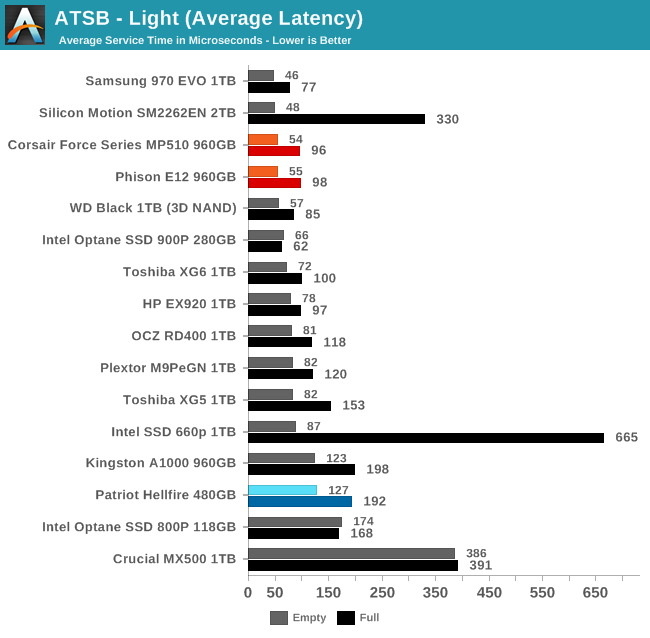
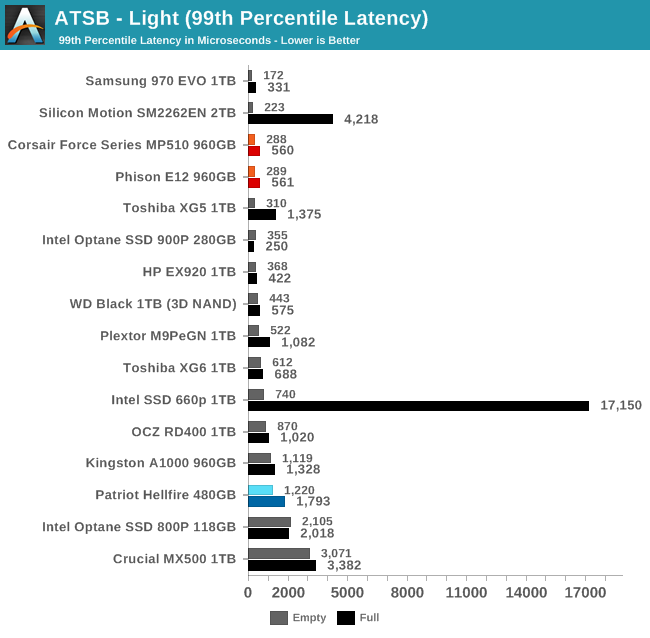
The average and 99th percentile latencies from the MP510 are very low, though most of the NVMe drives listed here have sub-millisecond 99th percentile latencies and the differences generally imperceptible for workloads this light.
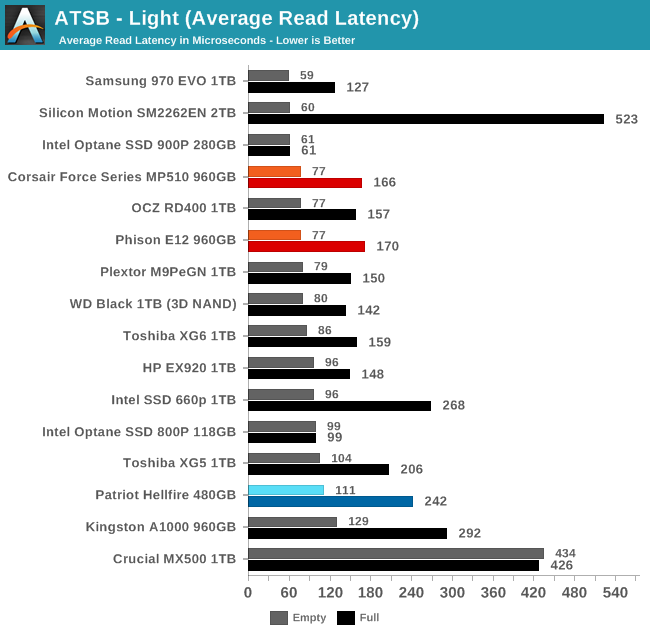
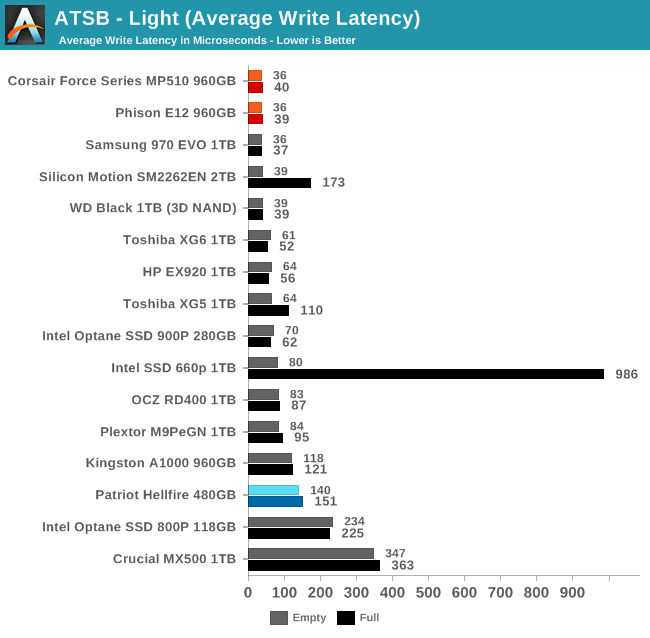
The MP510 continues to have some of the best write latencies and competitive read latencies, with the write latency in particular showing almost no penalty for running the test on a full drive.
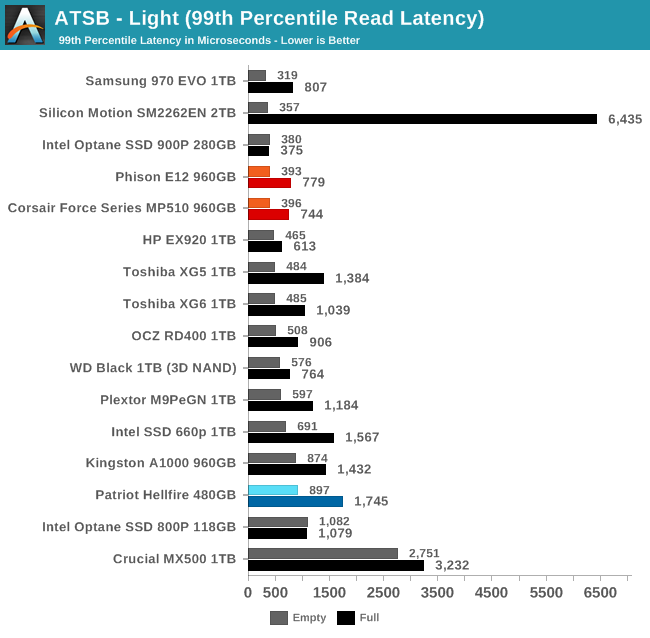
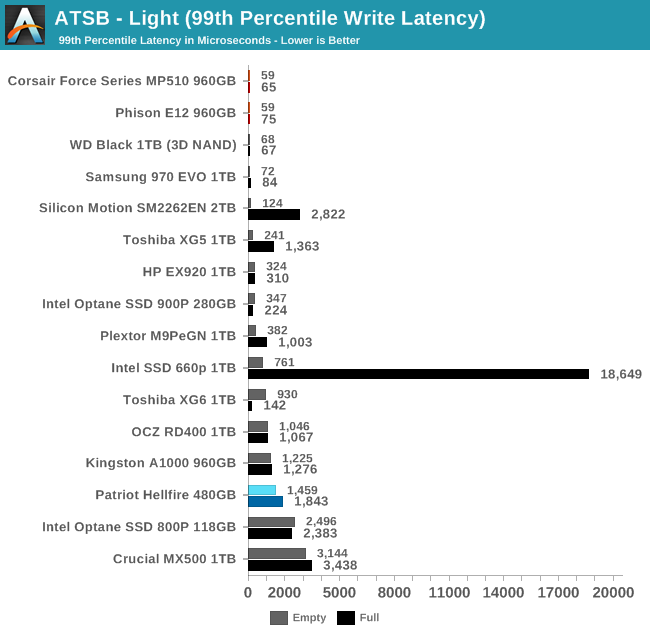 The 99th percentile write latency of the Corsair MP510 on the Light test is minimal, showing that the entire test operates within the very fast SLC write cache. The read latencies are very good, but don't set any records.
The 99th percentile write latency of the Corsair MP510 on the Light test is minimal, showing that the entire test operates within the very fast SLC write cache. The read latencies are very good, but don't set any records.
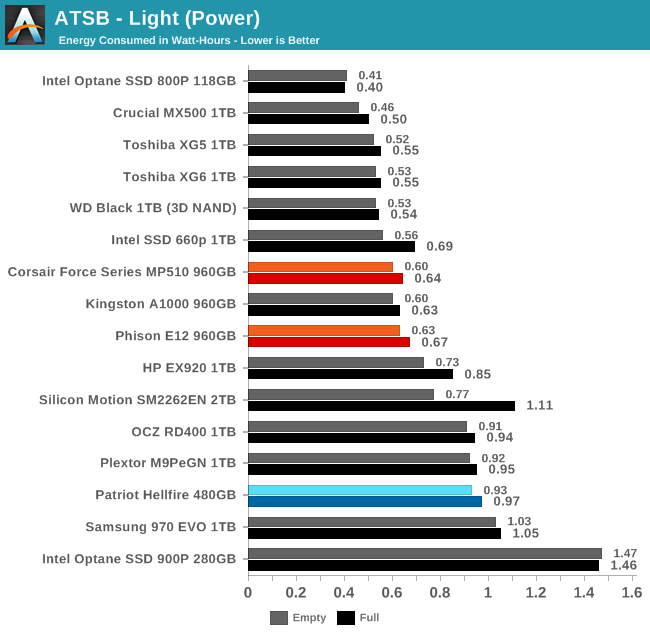
The energy usage by the MP510 during the Light test is a bit better than average but still about 30% higher than the Crucial MX500 mainstream SATA SSD.
Random Read Performance
Our first test of random read performance uses very short bursts of operations issued one at a time with no queuing. The drives are given enough idle time between bursts to yield an overall duty cycle of 20%, so thermal throttling is impossible. Each burst consists of a total of 32MB of 4kB random reads, from a 16GB span of the disk. The total data read is 1GB.
The Patriot Hellfire, in blue, is highlighted as an example of a last-generation Phison E7 drive. Although we didn't test it at the time, the MP500 was based on the same controller and memory.
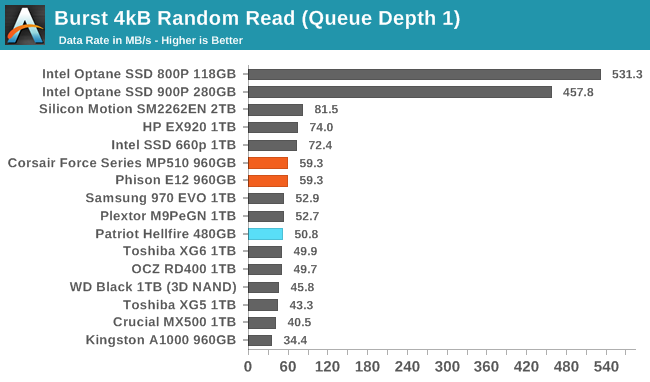
The Corsair Force MP510 can't match the burst random read performance of a Silicon Motion controller paired with IMFT 64L 3D TLC, but the MP510 has the fastest random reads of any drive using Toshiba/SanDisk BiCS TLC and it also beats the Samsung 970 EVO.
Our sustained random read performance is similar to the random read test from our 2015 test suite: queue depths from 1 to 32 are tested, and the average performance and power efficiency across QD1, QD2 and QD4 are reported as the primary scores. Each queue depth is tested for one minute or 32GB of data transferred, whichever is shorter. After each queue depth is tested, the drive is given up to one minute to cool off so that the higher queue depths are unlikely to be affected by accumulated heat build-up. The individual read operations are again 4kB, and cover a 64GB span of the drive.
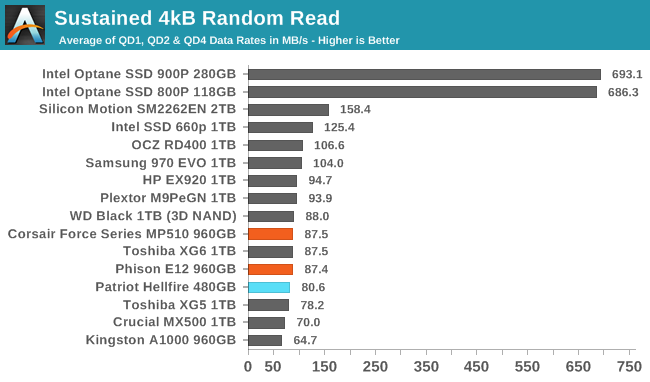
On the longer random read test that adds some higher queue depths, the MP510's performance standing falls somewhat as the Samsung 970 EVO and a few other drives with BiCS TLC overtake it, while Silicon Motion drives retain a commanding lead.
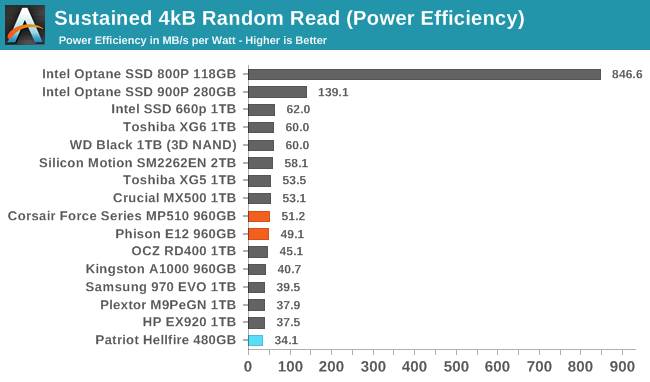 |
|||||||||
| Power Efficiency in MB/s/W | Average Power in W | ||||||||
The power efficiency of the MP510 during random reads is reasonable but is about 15% worse than what WD and Toshiba can do using their own controllers with this NAND.
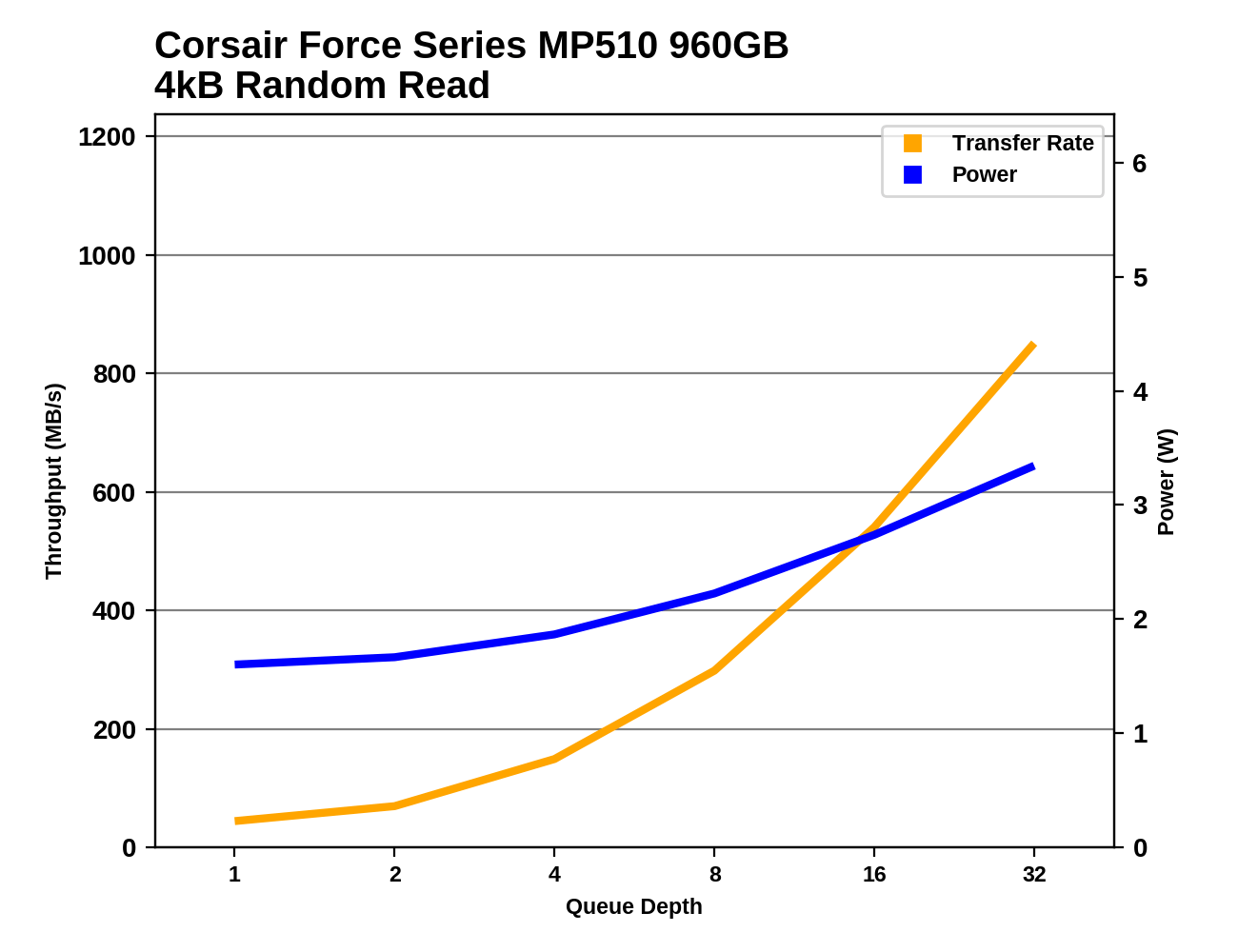 |
|||||||||
The MP510 may not provide the best random read performance at low queue depths, but its performance does scale up nicely when the queue depth continues to grow. By QD32 it is delivering over 800MB/s with a little more than 3W and showing no sign of approaching a performance ceiling; Phison's plans for enterprise drives based on this controller seem to have merit.
Random Write Performance
Our test of random write burst performance is structured similarly to the random read burst test, but each burst is only 4MB and the total test length is 128MB. The 4kB random write operations are distributed over a 16GB span of the drive, and the operations are issued one at a time with no queuing.
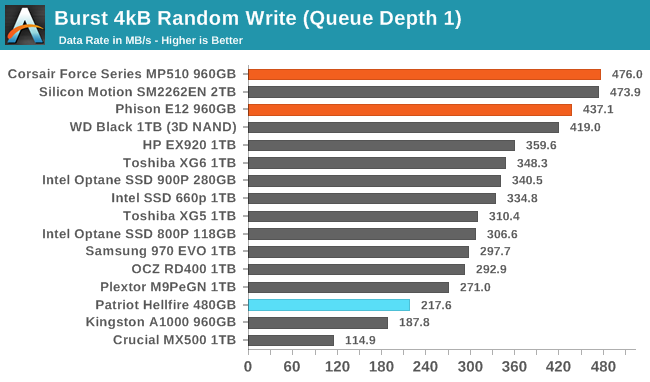
The Corsair Force MP510 is essentially tied for first place for burst random write performance: its SLC write cache has a very low latency.
As with the sustained random read test, our sustained 4kB random write test runs for up to one minute or 32GB per queue depth, covering a 64GB span of the drive and giving the drive up to 1 minute of idle time between queue depths to allow for write caches to be flushed and for the drive to cool down.
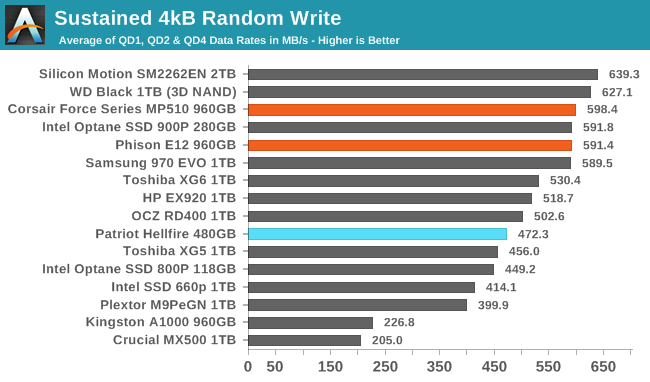
On the longer random write test, the Corsair MP510 loses the lead but stays in the top tier of high-performing drives.
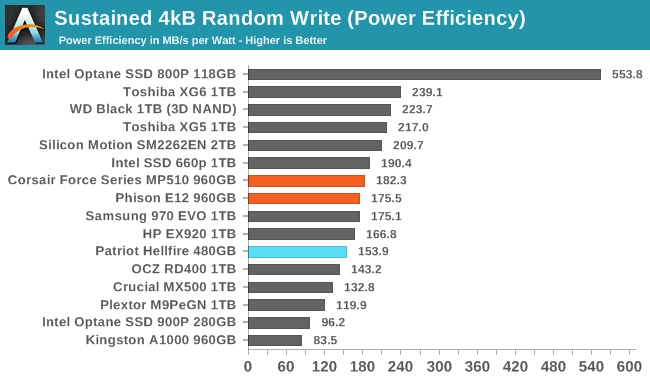 |
|||||||||
| Power Efficiency in MB/s/W | Average Power in W | ||||||||
The power efficiency of the Corsair Force MP510 during random writes is a bit better than average for NVMe drives, but significantly worse than what Toshiba and WD can do by pairing the same NAND with their own controllers. The WD Black manages this substantial efficiency advantage wil also slightly outperforming the MP510.
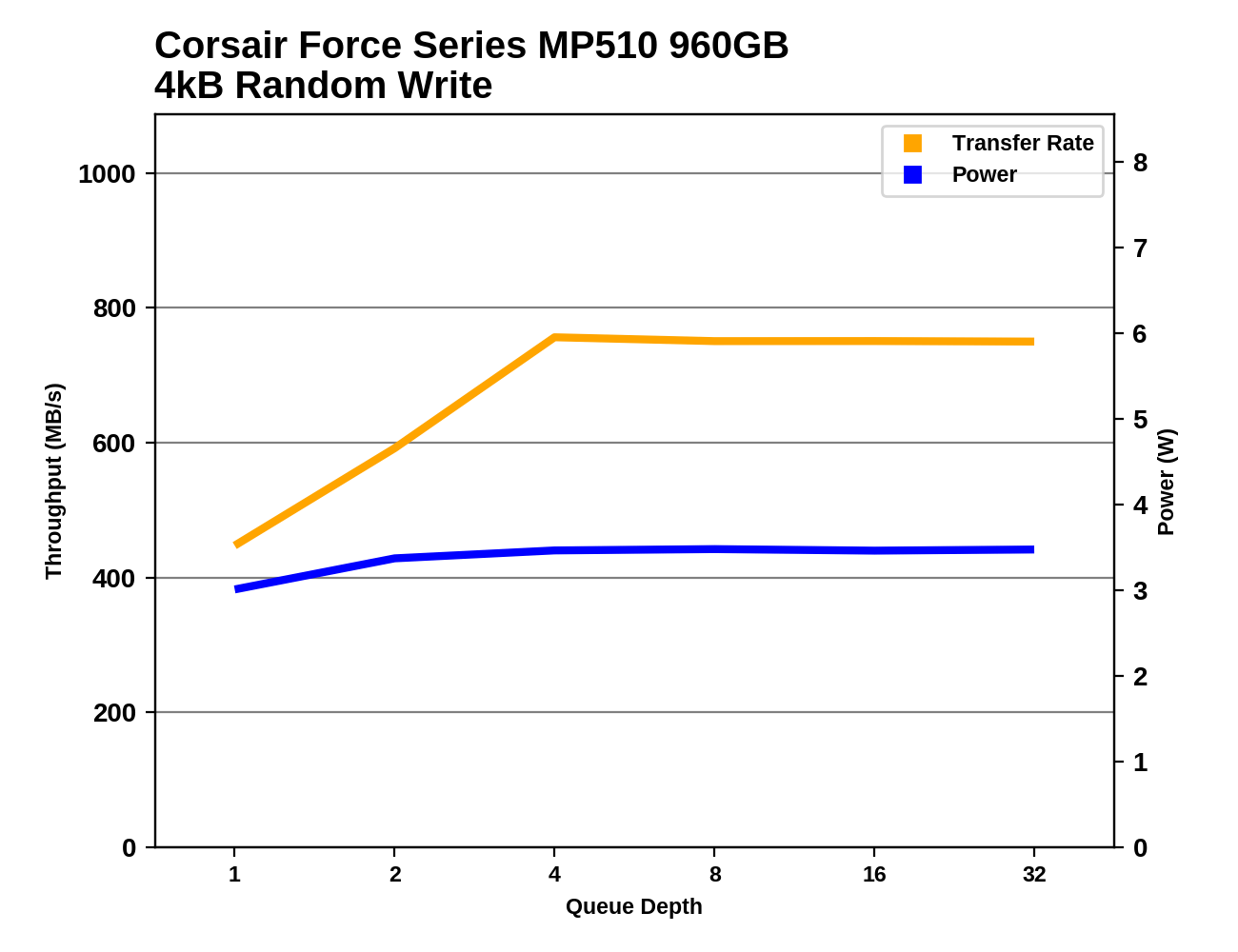 |
|||||||||
Like many of its closest competitors, the Corsair Force MP510's random write speed is saturated by QD4, but it plateaus well below the limit of the WD Black, which doesn't require any more power than the MP510.
Sequential Read Performance
Our first test of sequential read performance uses short bursts of 128MB, issued as 128kB operations with no queuing. The test averages performance across eight bursts for a total of 1GB of data transferred from a drive containing 16GB of data. Between each burst the drive is given enough idle time to keep the overall duty cycle at 20%.
The Patriot Hellfire, in blue, is highlighted as an example of a last-generation Phison E7 drive. Although we didn't test it at the time, the MP500 was based on the same controller and memory.
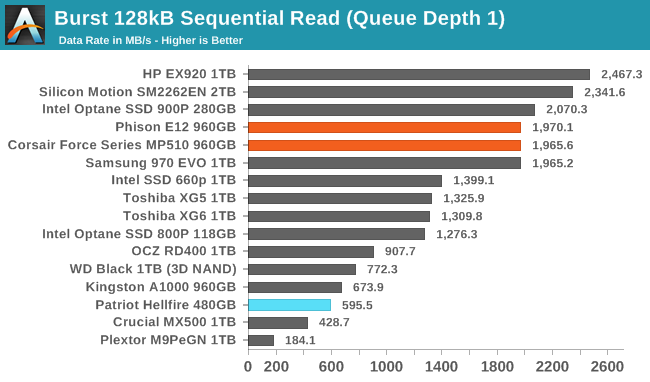
With a sequential read burst speed just shy of 2GB/s, the Corsair Force MP510 isn't the absolute fastest TLC drive on the market, but there isn't much that can beat it.
Our test of sustained sequential reads uses queue depths from 1 to 32, with the performance and power scores computed as the average of QD1, QD2 and QD4. Each queue depth is tested for up to one minute or 32GB transferred, from a drive containing 64GB of data. This test is run twice: once with the drive prepared by sequentially writing the test data, and again after the random write test has mixed things up, causing fragmentation inside the SSD that isn't visible to the OS. These two scores represent the two extremes of how the drive would perform under real-world usage, where wear leveling and modifications to some existing data will create some internal fragmentation that degrades performance, but usually not to the extent shown here.
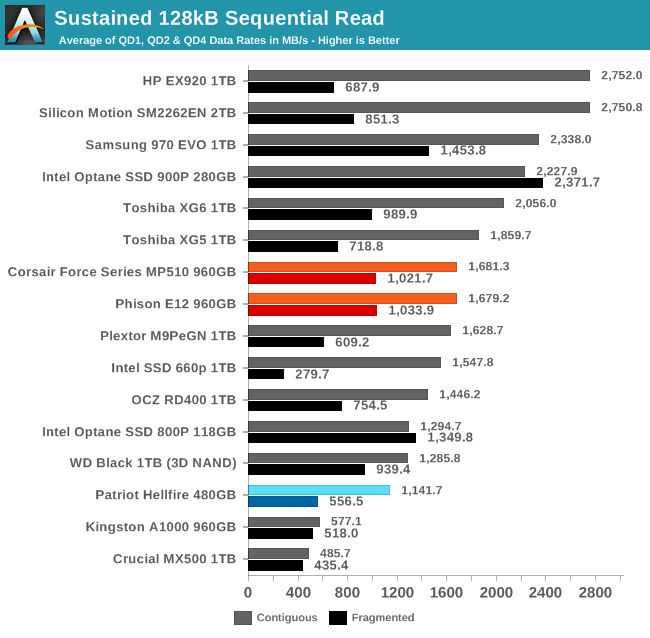
On the longer sequential read test, the MP510's standing falls and it is one of the slower drives in the current high-end NVMe segment. However, it does handle reading fragmented data better than most of its competitors.
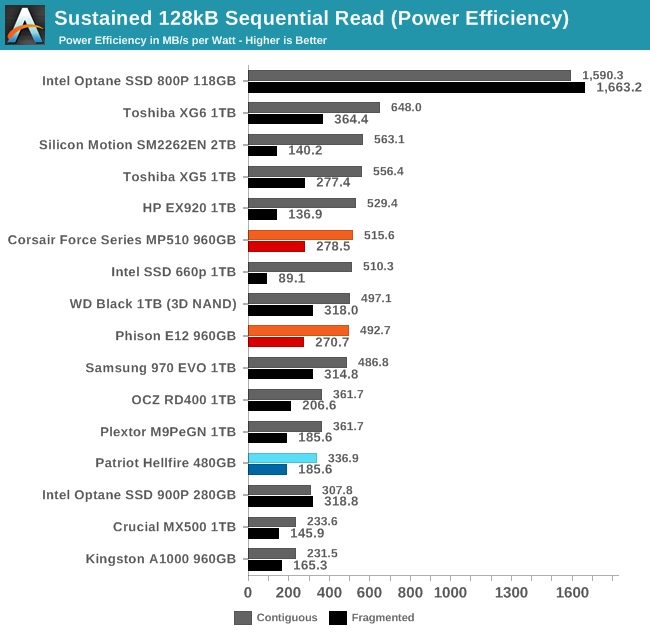 |
|||||||||
| Power Efficiency in MB/s/W | Average Power in W | ||||||||
The power efficiency of the MP510 on the sequential read test is similar to most of the other high-end competition, and the MP510 isn't setting any records.
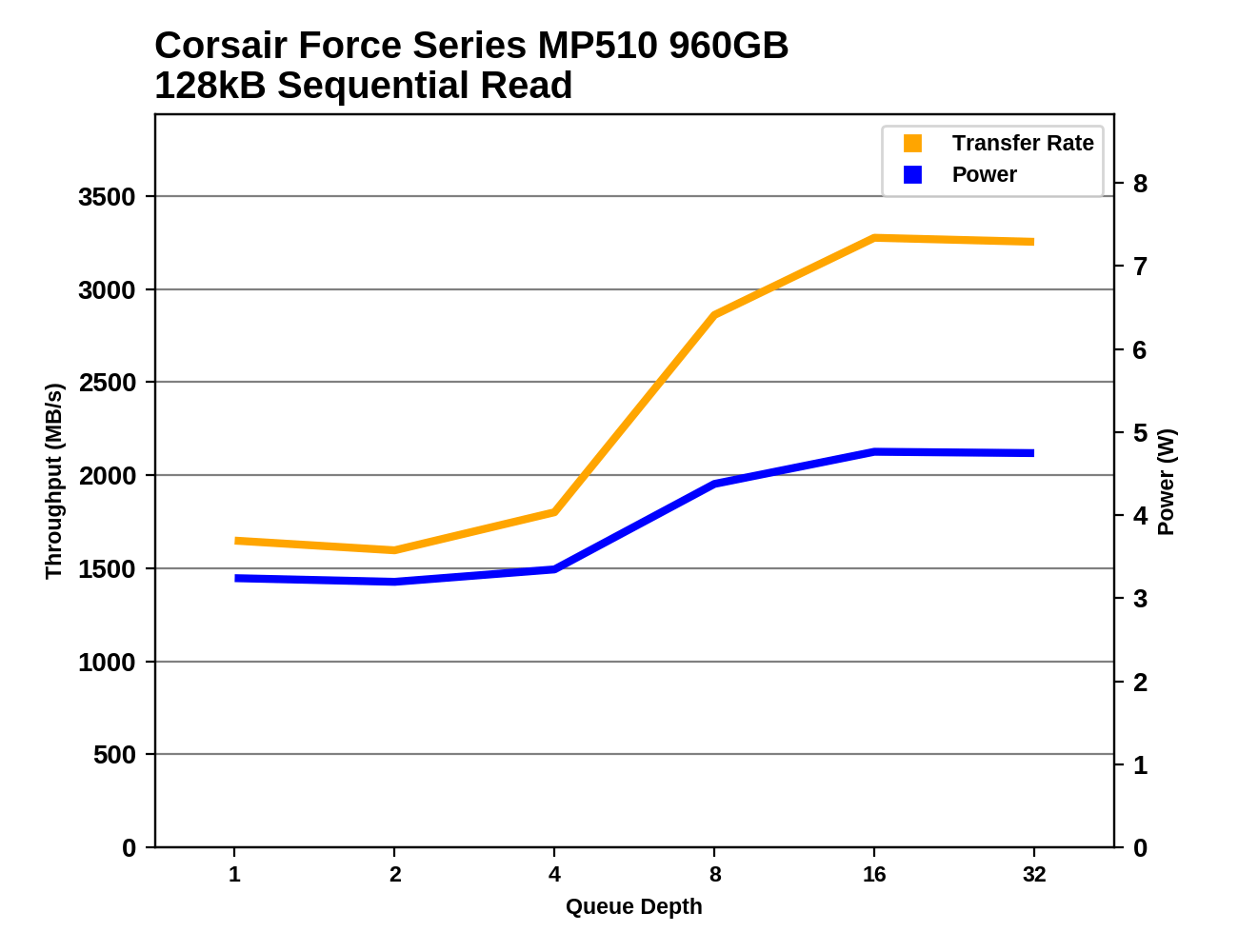 |
|||||||||
The Corsair Force MP510 hits quite high sequential read speeds when operating with a high enough queue depth, but it doesn't scale well at lower queue depths with QD4 performance only slightly higher than QD1.
Sequential Write Performance
Our test of sequential write burst performance is structured identically to the sequential read burst performance test save for the direction of the data transfer. Each burst writes 128MB as 128kB operations issued at QD1, for a total of 1GB of data written to a drive containing 16GB of data.
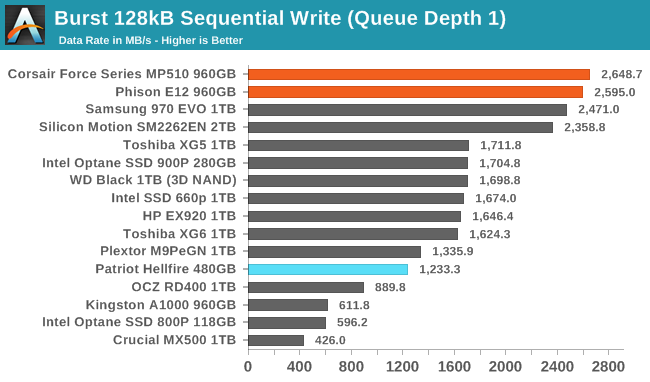
The Corsair Force MP510 handsle bursts of sequential writes just as well as it does random writes, so its SLC cache sets another record. Only a handful of drives can manage more than 2GB/s for QD1 writes, and the MP510 exceeds 2.6GB/s on this test.
Our test of sustained sequential writes is structured identically to our sustained sequential read test, save for the direction of the data transfers. Queue depths range from 1 to 32 and each queue depth is tested for up to one minute or 32GB, followed by up to one minute of idle time for the drive to cool off and perform garbage collection. The test is confined to a 64GB span of the drive.
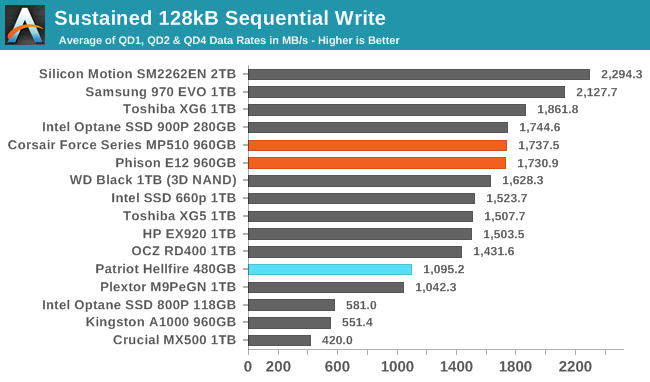
On the longer sequential write test that adds in some higher queue depths, the MP510 falls out of first place but stays in a fairly high performance tier.
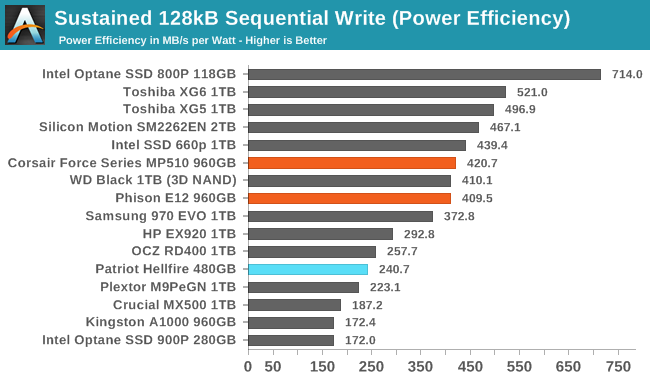 |
|||||||||
| Power Efficiency in MB/s/W | Average Power in W | ||||||||
The power efficiency of the MP510 during sequential writes is well below what the BiCS TLC NAND can manage when paired with Toshiba's controller, but still above average when considering the broader field of competition.
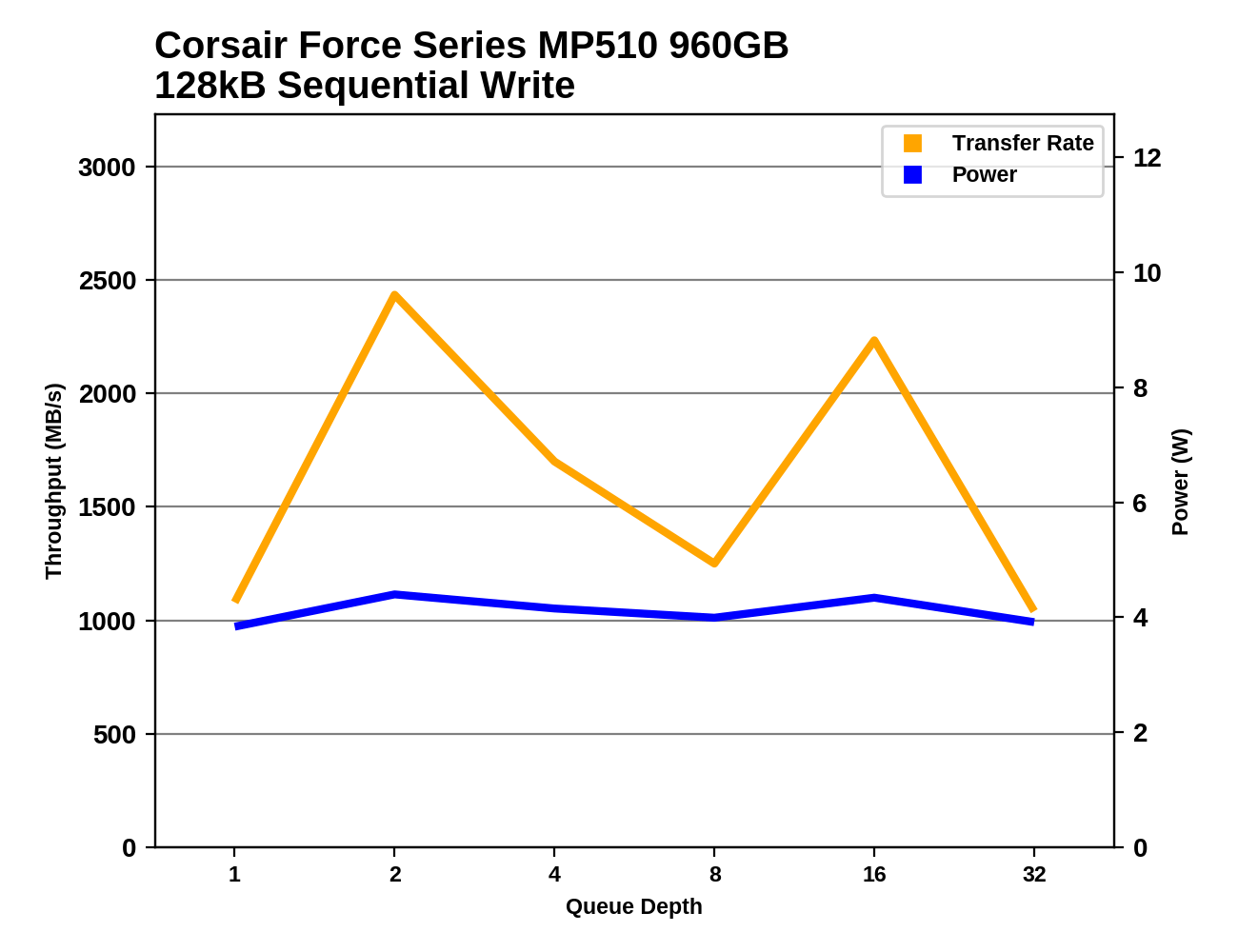 |
|||||||||
The Corsair Force MP510 shows unsteady performance during the sequential write test, indicating that the very fast SLC write cache does fill up and that can have a significant but temporary impact on performance. At its worst, the MP510 is still handling more than 1GB/s of writes on average, so filling up the SLC cache doesn't ruin performance.
Mixed Random Performance
Our test of mixed random reads and writes covers mixes varying from pure reads to pure writes at 10% increments. Each mix is tested for up to 1 minute or 32GB of data transferred. The test is conducted with a queue depth of 4, and is limited to a 64GB span of the drive. In between each mix, the drive is given idle time of up to one minute so that the overall duty cycle is 50%.
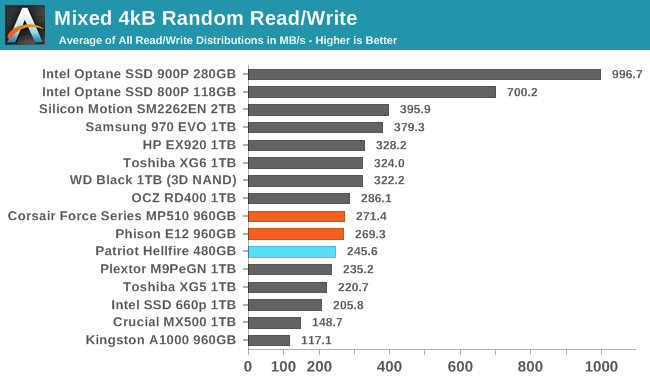
The Corsair Force MP510 demonstrated above average random read performance and top tier random writes, but the mixed workload results are average at best. The WD Black averages about 18% higher performance with the same NAND, and the Samsung 970 EVO is about 40% faster.
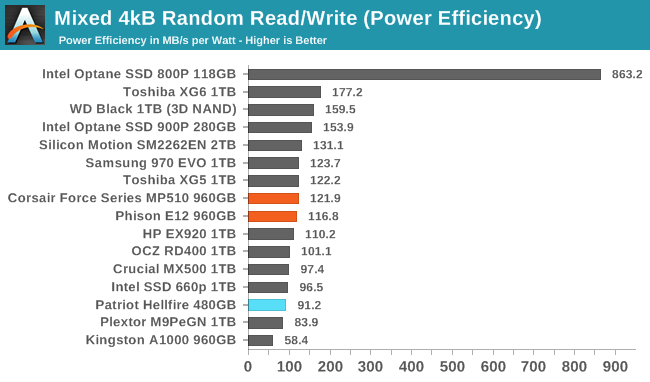 |
|||||||||
| Power Efficiency in MB/s/W | Average Power in W | ||||||||
As with performance, the power efficiency score from the MP510 is acceptable but nothing special compared to the Toshiba XG6 and WD Black.
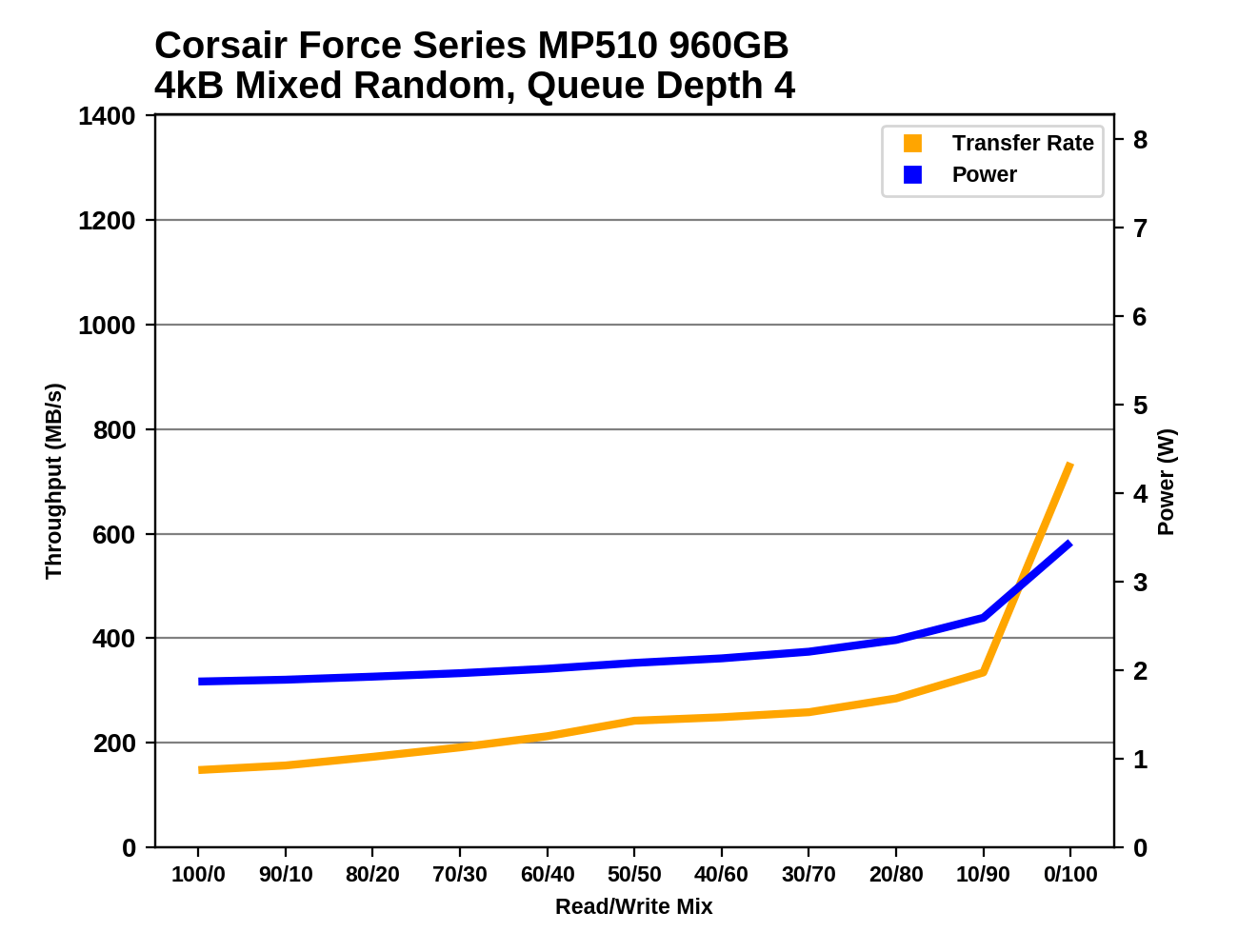 |
|||||||||
The unimpressive overall score from the MP510 on the mixed random I/O test seems to primarily stem from how it behaves during the more write-heavy half of the test. As the proportion of writes grows, the performance of the MP510 increases relatively slowly until the very end when performance spikes on the 100% cachable pure random write phase of the test.
Mixed Sequential Performance
Our test of mixed sequential reads and writes differs from the mixed random I/O test by performing 128kB sequential accesses rather than 4kB accesses at random locations, and the sequential test is conducted at queue depth 1. The range of mixes tested is the same, and the timing and limits on data transfers are also the same as above.
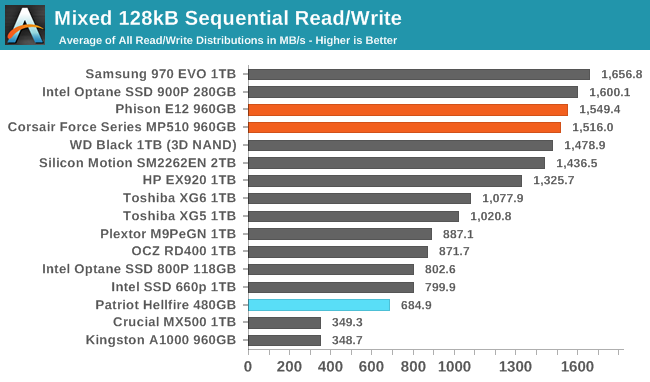
The Corsair Force MP510 provides excellent performance on our mixed sequential I/O test, but for once appears to be slightly slower than the Phison E12 engineering sample we tested earlier this year.
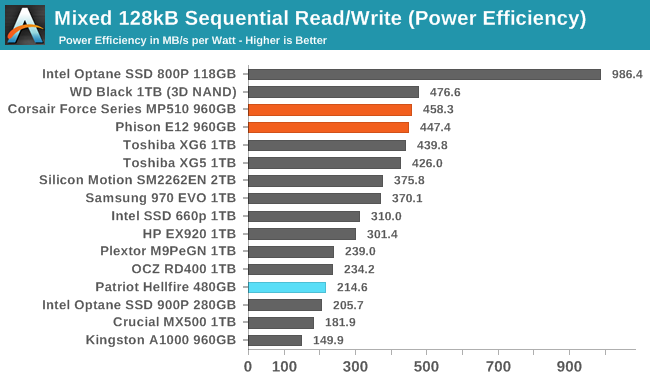 |
|||||||||
| Power Efficiency in MB/s/W | Average Power in W | ||||||||
The MP510 turns in an extremely good power efficiency score for the mixed sequential I/O test: only about 4% behind the class-leading WD Black, and 50% better than the HP EX920.
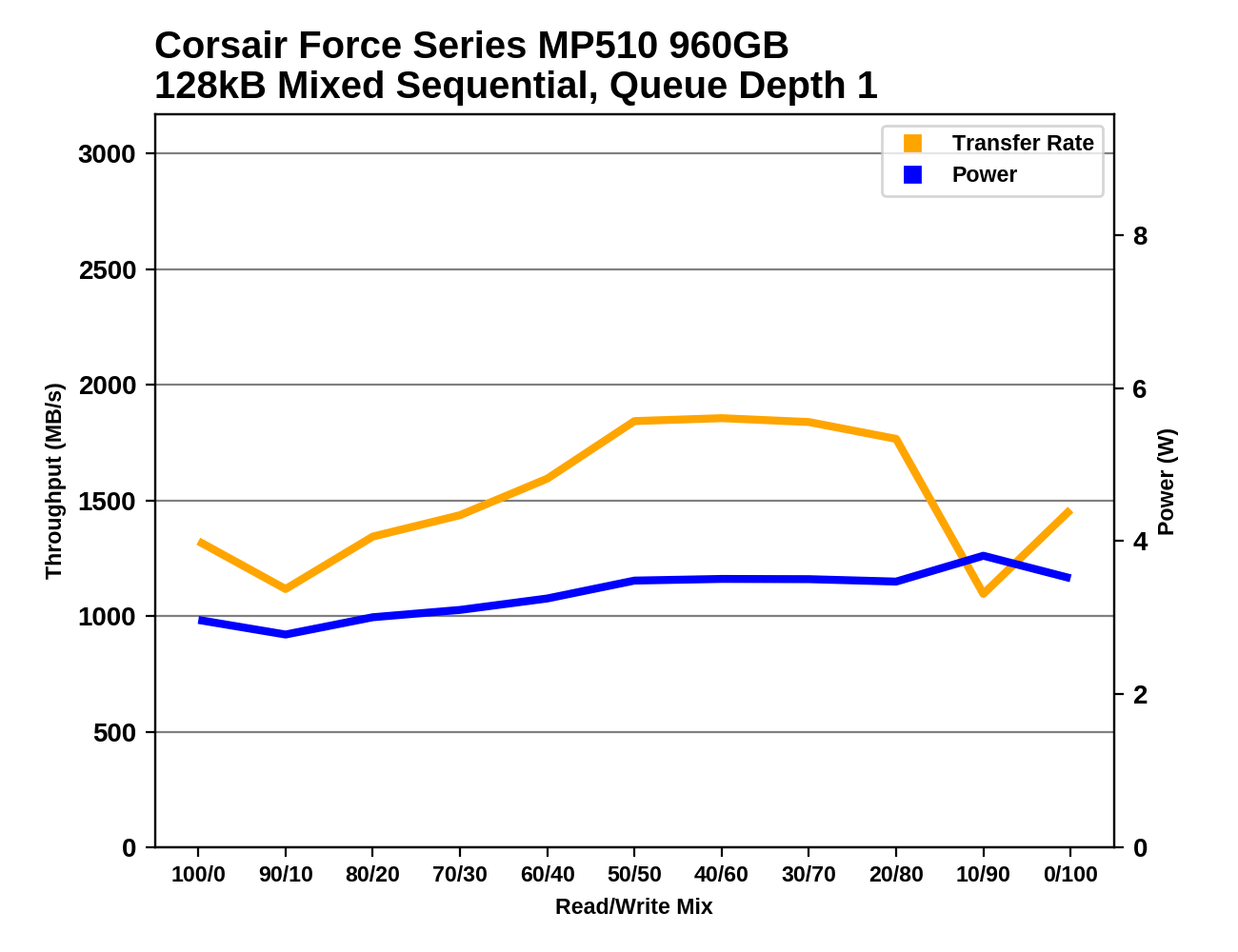 |
|||||||||
The performance curve of the Corsair Force MP510 on the mixed sequential I/O test looks rather unusual, with performance jumping around a bit and at its best during the more write-heavy half of the test. Most drives show a more typical bathtub curve with the best performance at either end of the test, but the WD Black's behavior does show similarities to the MP510.
Power Management Features
Real-world client storage workloads leave SSDs idle most of the time, so the active power measurements presented earlier in this review only account for a small part of what determines a drive's suitability for battery-powered use. Especially under light use, the power efficiency of a SSD is determined mostly be how well it can save power when idle.
For many NVMe SSDs, the closely related matter of thermal management can also be important. M.2 SSDs can concentrate a lot of power in a very small space. They may also be used in locations with high ambient temperatures and poor cooling, such as tucked under a GPU on a desktop motherboard, or in a poorly-ventilated notebook.
| Corsair Force MP510 NVMe Power and Thermal Management Features |
|||
| Controller | Phison PS5012-E12 | ||
| Firmware | ECFM11.0 | ||
| NVMe Version |
Feature | Status | |
| 1.0 | Number of operational (active) power states | 2 | |
| 1.1 | Number of non-operational (idle) power states | 3 | |
| Autonomous Power State Transition (APST) | Supported | ||
| 1.2 | Warning Temperature | 70 °C | |
| Critical Temperature | 90 °C | ||
| 1.3 | Host Controlled Thermal Management | Supported | |
| Non-Operational Power State Permissive Mode | Not Supported | ||
The Corsair Force MP510 implements all the usual NVMe power management features and has a comfortably high thermal throttling point. The drive's declared maximum power levels for the active power states look alarmingly high, but our testing didn't push the MP510 anywhere near the claimed 10.73W peak. The idle power states advertise low idle power with quick transition latencies, and our testing of power state 3 shows that the drive isn't exaggerating at all.
| Corsair Force MP510 NVMe Power States |
|||||
| Controller | Phison PS5012-E12 | ||||
| Firmware | ECFM11.0 | ||||
| Power State |
Maximum Power |
Active/Idle | Entry Latency |
Exit Latency |
|
| PS 0 | 10.73 W | Active | - | - | |
| PS 1 | 7.69 W | Active | - | - | |
| PS 2 | 6.18 W | Active | - | - | |
| PS 3 | 49 mW | Idle | 2 ms | 2 ms | |
| PS 4 | 1.8 mW | Idle | 25 ms | 25 ms | |
Note that the above tables reflect only the information provided by the drive to the OS. The power and latency numbers are often very conservative estimates, but they are what the OS uses to determine which idle states to use and how long to wait before dropping to a deeper idle state.
Idle Power Measurement
SATA SSDs are tested with SATA link power management disabled to measure their active idle power draw, and with it enabled for the deeper idle power consumption score and the idle wake-up latency test. Our testbed, like any ordinary desktop system, cannot trigger the deepest DevSleep idle state.
Idle power management for NVMe SSDs is far more complicated than for SATA SSDs. NVMe SSDs can support several different idle power states, and through the Autonomous Power State Transition (APST) feature the operating system can set a drive's policy for when to drop down to a lower power state. There is typically a tradeoff in that lower-power states take longer to enter and wake up from, so the choice about what power states to use may differ for desktop and notebooks.
We report two idle power measurements. Active idle is representative of a typical desktop, where none of the advanced PCIe link or NVMe power saving features are enabled and the drive is immediately ready to process new commands. The idle power consumption metric is measured with PCIe Active State Power Management L1.2 state enabled and NVMe APST enabled if supported.
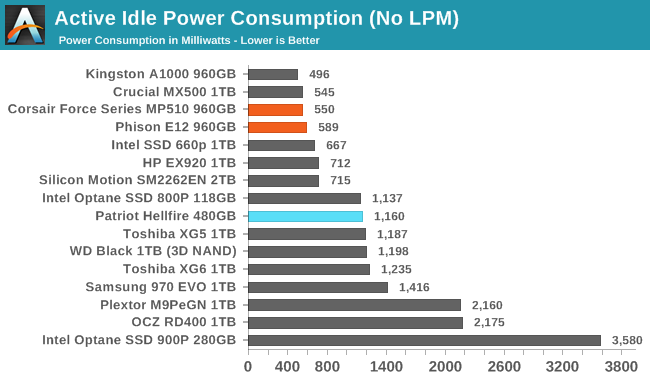
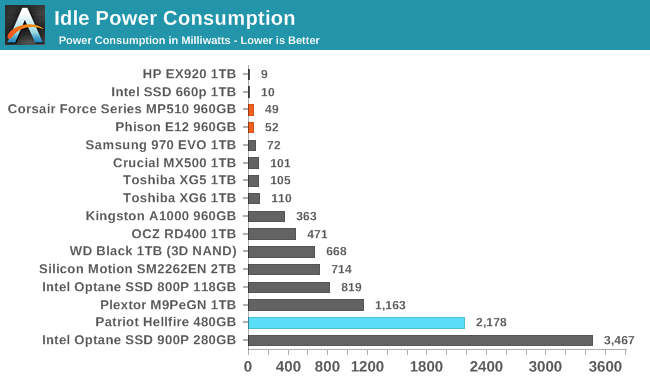
The Corsair Force MP510 has the best active idle power consumption we've seen from a high-end NVMe SSD, and with APST enabled it is second only to Silicon Motion's latest generation of NVMe controllers in deep sleep power savings on our desktop testbed.
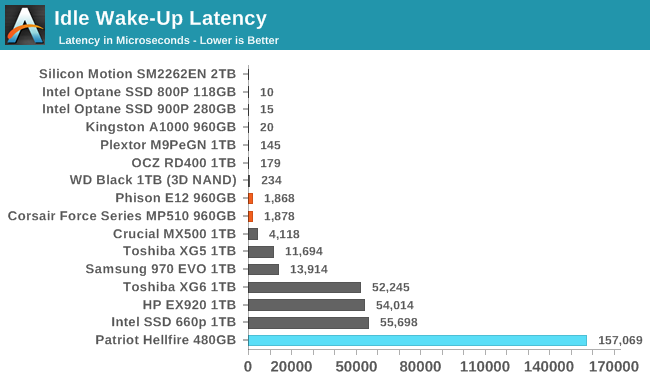
This is complemented by a nice quick wakeup from sleep, so aggressive power management settings won't hurt system responsiveness.
Conclusion
The Corsair Force Series MP510 is not the fastest drive we've tested, but it offers competitive high-end performance on almost every test in our suite, and sets a few records of its own. The MP510 returns top notch scores across all of our ATSB tests that replicate real-world I/O patterns, and the comparative weaknesses where the MP510 doesn't impress is mostly in the synthetic tests that are least relevant to everyday real world use. The closest the MP510 comes to mediocrity on a performance test is its random read scores, but even here it scores very well on the short burst QD1 test and only falls below par on the longer sustained random read test that is much less representative of typical client computing usage.
The power efficiency is above average for NVMe SSDs, but doesn't quite match the Toshiba XG series and the WD Black, both of which use the same NAND with different controllers. The idle power management is effective and trouble-free on our testbed, a welcome surprise for a drive using a Phison NVMe controller.
Overall, the Corsair Force MP510 shows that the Phison E12 controller paired with Toshiba's 64-layer 3D TLC NAND is a winning combination that is well-equipped to compete against any other high-end SSD on the market. It's a very well-rounded product that doesn't make any severe sacrifices in pursuit of higher benchmark numbers. After Phison's first-generation E7 NVMe SSD controller (used in the Corsair Force MP500) failed to deliver competitive high-end performance, it's great to see this generation produce such a strong competitor. Phison E7 drives with planar MLC NAND are barely able to compete with today's entry-level TLC and QLC NVMe SSDs, and the new Phison E12 is in an entirely different league.
There's still room for improvement with the E12 SSD controller, and Phison will undoubtedly keep refining their firmware long after the hardware has shipped, as they have done for previous controllers. We've heard that Phison is working to address at least one performance problem that our test suite does not expose. This is not to suggest that the E12 platform is immature—it is definitely ready to be on the shelves and entering consumer desktops and notebooks. Not every brand that sells Phison-based SSDs bothers to support them by delivering firmware updates after release, but Corsair's SSD Toolbox software takes care of that.
| High-End NVMe SSD Price Comparison | |||
| 240-280GB | 480-512GB | 960GB-1TB | |
| Corsair Force MP510 | $65.99 (27¢/GB) | $124.99 (26¢/GB) | $235.99 (25¢/GB) |
| MyDigitalSSD BPX Pro | $74.99 (31¢/GB) | $129.99 (27¢/GB) | $259.99 (27¢/GB) |
| ADATA XPG SX8200 | $67.99 (28¢/GB) | $109.99 (23¢/GB) | $214.99 (22¢/GB) |
| HP EX920 | $79.99 (31¢/GB) | $119.99 (23¢/GB) | $209.99 (21¢/GB) |
| Western Digital WD Black (2018) | $85.48 (34¢/GB) | $129.99 (26¢/GB) | $289.99 (29¢/GB) |
| Samsung 970 EVO | $87.99 (35¢/GB) | $139.99 (28¢/GB) | $277.99 (28¢/GB) |
Every brand in the consumer SSD market now has access to the ingredients for a good high-end NVMe drive. Great controllers are no longer the exclusive territory of giants like Samsung, as even smaller brands can make use of reference designs from Phison and Silicon Motion. Corsair is not the first to bring a Phison E12 drive to market, but they are a bit ahead of the coming deluge of E12-based SSDs. The MP510 will face the most fiercely competitive high-end SSD segment the market has seen since the introduction of PCIe SSDs. Corsair has never been known for being particularly aggressive with their SSD pricing but their introductory MSRPs for the MP510 are actually slightly better than the MyDigitalSSD BPX Pro, another Phison E12 SSD from a vendor that is known for very competitive pricing. NAND flash prices are still dropping so the price landscape today is likely very different from what we'll see in the holiday sales starting next month, but at the moment the Corsair Force MP510 seems like a pretty good deal for a high-end NVMe SSD.

